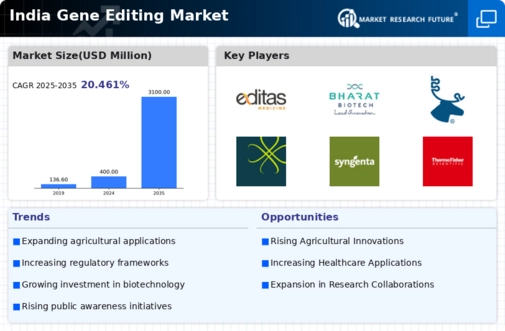Rising Demand for Precision Medicine
The gene editing market in India is experiencing a notable surge in demand for precision medicine, which tailors treatment to individual genetic profiles. This shift is driven by an increasing prevalence of genetic disorders and chronic diseases, prompting healthcare providers to seek innovative solutions. The market for precision medicine is projected to grow at a CAGR of approximately 12% from 2025 to 2030. As a result, the gene editing market is positioned to benefit significantly from advancements in CRISPR technology and other gene editing tools, which enable targeted therapies. Furthermore, the Indian government is actively promoting research and development in this area, indicating a supportive environment for the gene editing market. This trend suggests that the integration of gene editing into clinical practice could revolutionize treatment paradigms, enhancing patient outcomes and reducing healthcare costs.
Collaborative Efforts in Biotechnology
Collaborative efforts among various stakeholders are significantly influencing the gene editing market in India. Partnerships between academic institutions, government agencies, and private companies are fostering innovation and accelerating the development of gene editing technologies. These collaborations often focus on addressing specific challenges, such as disease resistance in crops or genetic disorders in humans. The Indian government has initiated several programs to promote public-private partnerships, which have resulted in increased funding and resource sharing. As of 2025, collaborative projects in biotechnology have seen a 20% rise in participation, indicating a robust interest in advancing the gene editing market. Such synergies not only enhance research capabilities but also facilitate the translation of scientific discoveries into practical applications, thereby driving market growth.
Advancements in Research Infrastructure
The gene editing market in India is benefiting from significant advancements in research infrastructure. Institutions and universities are increasingly investing in state-of-the-art laboratories and facilities dedicated to genetic research. This trend is supported by government initiatives aimed at fostering innovation and collaboration among academic and industrial stakeholders. The establishment of specialized research centers has led to a more robust ecosystem for gene editing technologies. As of 2025, the Indian government has reported a 15% increase in funding for biotechnology research, which directly impacts the gene editing market. Enhanced research capabilities are likely to accelerate the development of novel gene editing applications, thereby attracting both domestic and international investments. This environment of innovation is crucial for positioning India as a leader in the gene editing market.
Growing Public Awareness and Acceptance
Public awareness and acceptance of gene editing technologies are emerging as vital drivers for the gene editing market in India. As educational initiatives and media coverage increase, the general population is becoming more informed about the potential benefits and risks associated with gene editing. This growing awareness is fostering a more favorable perception of gene editing applications in healthcare and agriculture. Surveys indicate that approximately 60% of the Indian population supports the use of gene editing for medical treatments and crop improvement. This acceptance is crucial for the gene editing market, as it encourages investment and research in these areas. Furthermore, as ethical discussions surrounding gene editing evolve, public engagement will likely play a pivotal role in shaping regulatory frameworks and guiding the responsible use of these technologies.
Investment in Agricultural Biotechnology
Investment in agricultural biotechnology is a critical driver for the gene editing market in India. The country faces challenges such as food security and climate change, necessitating innovative agricultural solutions. Gene editing technologies, particularly CRISPR, are being utilized to develop crops that are more resilient to environmental stressors and pests. The Indian government has allocated approximately $200 million to support research in agricultural biotechnology, which is expected to bolster the gene editing market. This financial backing, combined with the increasing adoption of genetically modified organisms (GMOs), indicates a growing acceptance of gene editing in agriculture. As farmers seek higher yields and sustainable practices, the gene editing market is likely to expand, providing tools that enhance crop productivity and nutritional value.




















Leave a Comment